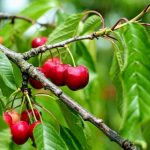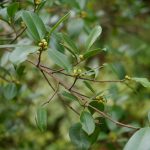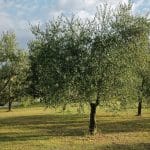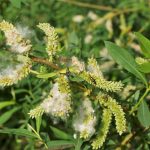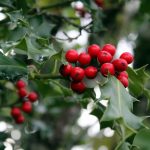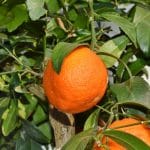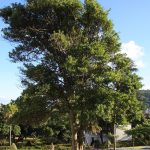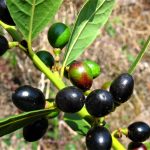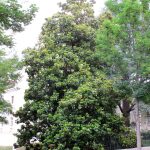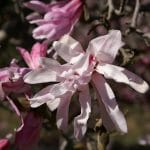
Did you know that there are many trees that reproduce by cuttings? This method of multiplication has been used for a long time, since it allows to have new plants, of good size, at practically zero cost and in a short time. If we think that an average tree takes about 2 years to reach 40 centimeters in height, which is what the cutting usually measures, with the latter we save those two years of waiting.
Today a large part of garden trees that are sold began their life as cuttings. So that, Let's see which are the most recommended.
Trees that reproduce by woody cutting
The woody cutting is one that, as its name suggests, is a branch that has already lignified. It is used on deciduous trees basically, although there are exceptions. For example:
Cherry (Prunus avium)
- Image - Wikimedia / H. Zell
El cerezo It is a deciduous fruit tree that can be 30 meters high. In spring it produces numerous flowers, and shortly afterwards some fruits, cherries, which have a sweet taste. But during the autumn its leaves turn orange, making it a fruit species with a very high ornamental value. It resists frosts down to -18ºC.
Ficus (All varieties of Ficus)
- Image - Wikimedia / DO'Neil
- Image - Wikimedia / Dinesh Valke
- Image - Wikimedia / Sten
The Rubber plant They are evergreen or deciduous trees, depending on the species, which tend to grow fast and exceed 10 meters in height. They all produce figs, although not all are fit for human consumption. The most resistant to cold is the ficus carica, known as a fig tree, which is deciduous and supports up to -7ºC (the rest are much more sensitive to low temperatures).
Olive (Olea europaea)
- Image - Wikimedia / Burkhard Mücke
- Image - Wikimedia / Forest & Kim Starr
El olive it is one of the few evergreen trees that is multiplied by cuttings. It grows to about 15 meters in height, and has lanceolate leaves of a dark grayish green color on the upper surface, and paler on the underside. Towards the summer it produces its edible fruits, which are olives, from which olive oil is obtained.. Supports up to -12ºC.
Elms (Ulmus and Zelkova)
- Image - Wikimedia / タ ク ナ ワ ン
- Image - Wikimedia / KENPEI
- Image - Wikimedia / Le.Loup.Gris
All those trees that are known as elms, both those of the genus ulmus, which are the "true" as the Zelkova, which are known as Chinese elms due to their place of origin, are multiplied by woody cuttings. Its leaves are deciduous, and their height once they reach adulthood is 20-30 meters. They all resist moderate frosts well, down to -20ºC.
Sauce (All varieties of Salix)
- Image - Wikimedia / Dalgial
- Image - Wikimedia / Krzysztof Ziarnek, Kenraiz
- Image - Wikimedia / Liné1
The Sauces, like the weeping willowsalix babylonica) They are trees, usually deciduous but there are semi-evergreen, fast growing, which reach an approximate height of 10-15 meters. Some have a "weeping" crown, with hanging branches. They are usually short-lived trees, but the 50-60 years that they can live greatly beautify a garden. They resist up to 18ºC.
Trees that multiply by semi-woody cutting
Semi-woody cuttings are those that are obtained from branches that are one year old, but that are already beginning to lignify. These come from generally evergreen trees, which have ornamental and / or fruit interest. For example:
Holly (Holly aquifolium)
- Ilex aquifolium 'Golden Milkboy' // Image - Flickr / Leonora (Ellie) Enking
El holly It is an evergreen tree that grows between 6 and 15 meters in height, at a fairly slow rate. It has a pyramidal shape, leathery leaves, and red fruits -drupes- that ripen in winter.. It resists without problems the frosts of up to -18ºC.
Citrus (All Citrus)
Orange, lemon, mandarin, ... If you have a citric, you can multiply it by semi-woody cuttings. These are relatively small trees, rarely exceeding 7 meters in height, and that towards the summer they produce a rounded fruit whose pulp is divided into segments, which have some edible use. Of course, they are sensitive to frost. They will withstand the weak (up to -2ºC) without problems if they are punctual, but if it drops below -4ºC you will have to protect them.
laurel (Laurus nobilis)
- Image - Wikimedia / Wo st 01
- Image - Wikimedia / SABENCIA Bertu Ordiales
The laurel is an evergreen tree that can be up to 15 meters high. Its leaves are aromatic, so they are used a lot to flavor different dishes. It resists drought very, very well; in fact, if it is in the ground and has been in place for more than a year, it will be able to live if it rains only a few times a year. In addition, it resists up to -12ºC, but yes, it is sensitive to the attack of mealybugs.
Lilac (Syringa vulgaris)
- Image - Wikimedia / Salicyna
La lilac It is a deciduous tree that reaches a height of between 3 and 7 meters. It produces flowers in spring, lilac or white depending on the variety, and fragrant. For this reason, it is widely cultivated both in gardens and on terraces, since it also supports frosts, down to -15ºC.
Magnolia (All varieties of Magnolia)
- Image - Wikimedia / Nolege
- Image - Wikimedia / David J. Stang
Magnolias are trees that are generally deciduous, except the magnolia grandiflora which is evergreen. They grow quite slow, but multiply well by semi-woody cuttings. Spring is when they produce their precious aromatic flowers. They resist cold well: M. grandiflora holds up to -12ºC, and deciduous varieties up to -18ºC.
Do you know other trees that reproduce by cuttings?


